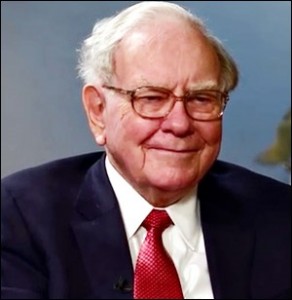By Pam Martens and Russ Martens: May 8, 2017
On Thursday of last week, legendary investor Warren Buffett, CEO of Berkshire Hathaway, told CNBC that his company had sold about one-third of its big stake in IBM during the first and second quarters of 2017. From a position of approximately 81 million shares of IBM, Berkshire’s stake is now believed to be in the 50 million share range. Buffett said he no longer values IBM the same way he did in 2011 when he began acquiring his large position.
The big puzzle for Buffett watchers is why he ever bought IBM. A simple glance at the stock’s long-term chart shows the company has been an underperformer for a very long time.
Back in 2013, Wall Street On Parade compared the performance of IBM, a tech company, to that of Procter and Gamble, a presumably less-sexy household products company. We found the following:
“After 30 years, $1000 invested in Procter and Gamble grew by 2,168 percent to $22,684 – not including the cash it was paying you in dividends for 30 years. The same $1000 (actually $976) invested on the same date 30 years ago in IBM, grew to a measly $8,467 or 767 percent – and that’s with the dividend reinvested…”
Both Procter and Gamble and IBM provide the public with stock performance calculators on their web sites. You can do the math yourself, selecting various start dates. This morning, we put in a start date of May 5, 1987 at IBM’s calculator – 30 years from this past Friday’s close. It showed a return of 519.59% and that’s with dividends reinvested. Procter and Gamble has delivered more than four times that return with dividends reinvested.
We’re a bit skeptical of Buffett’s foray into IBM because of his past White Knight adventures into downtrodden stocks. Back in 1987 Buffett took a $700 million stake in Salomon Brothers’ convertible preferred stock, giving him an approximate 12 percent stake in the company. A short four years later, top executives were under investigation for concealing efforts by traders to rig the U.S. Treasury auction. Buffett stepped in as Interim Chairman of Salomon to save the company.
This is how Linda Grant, writing for the Los Angeles Times, described the situation on August 16, 1991:
“ ‘Salomon was like an airplane that had suddenly lost all its forward motion. Everything stopped,’ recalls then co-head of investment banking Deryck C. Maughan. Chairman John H. Gutfreund and President Thomas W. Strauss had resigned earlier that day. Vice Chairman John W. Meriwether was under a cloud of suspicion that would lead to his resignation two days later. The stock had been suspended from trading, after losing a market value of $1.3 billion in one week. Jittery bankers were threatening to cut back loans. Investors were boycotting Salomon’s commercial paper. Prestigious customers, primarily public institutions such as the World Bank and the California Public Employees Retirement System, had suspended certain business dealings. The Justice Department’s antitrust division and the Securities and Exchange Commission had launched investigations.”
Buffett’s White Knight strategy worked. Six years later, Salomon Brothers was sold to Sanford Weill’s Travelers Group in a $9 billion stock swap.
Then there was Buffett’s confidence-boosting foray into Goldman Sachs at the height of the financial crisis in September 2008 as iconic Wall Street brands were in meltdown. Buffett’s Berkshire Hathaway took a $5 billion preferred share stake in Goldman with an eye-popping dividend of 10 percent at a time when Goldman Sachs’ share price was in a precipitous descent. Berkshire also received five-year warrants to purchase $5 billion of Goldman’s common stock with a strike price of $115 per share.
To put the best face on his Goldman rescue, Buffett released the following statement:
“Goldman Sachs is an exceptional institution. It has an unrivaled global franchise, a proven and deep management team and the intellectual and financial capital to continue its track record of outperformance.”
Goldman bought back the preferred shares from Buffett in 2011. In a revised deal, Berkshire executed its warrants with Goldman in 2013.
IBM is one of the 30 stocks that make up the Dow Jones Industrial Average. Goldman Sachs is likewise one of the Dow 30. What is good for the Dow 30 is good for Warren Buffett’s Berkshire Hathaway. Maybe that’s a key influence in how Buffett thinks about his investment strategy.
Editor’s Note: Past performance is no guarantee of future results. The Martens hold long term positions in Procter and Gamble stock. The information that appears on this site cannot, and does not, take into account your particular investment goals, your unique financial situation or income needs and is not intended to be recommendations appropriate for you. When it comes to making your own investment decisions, you should always consult in advance with your financial advisor and accountant.


